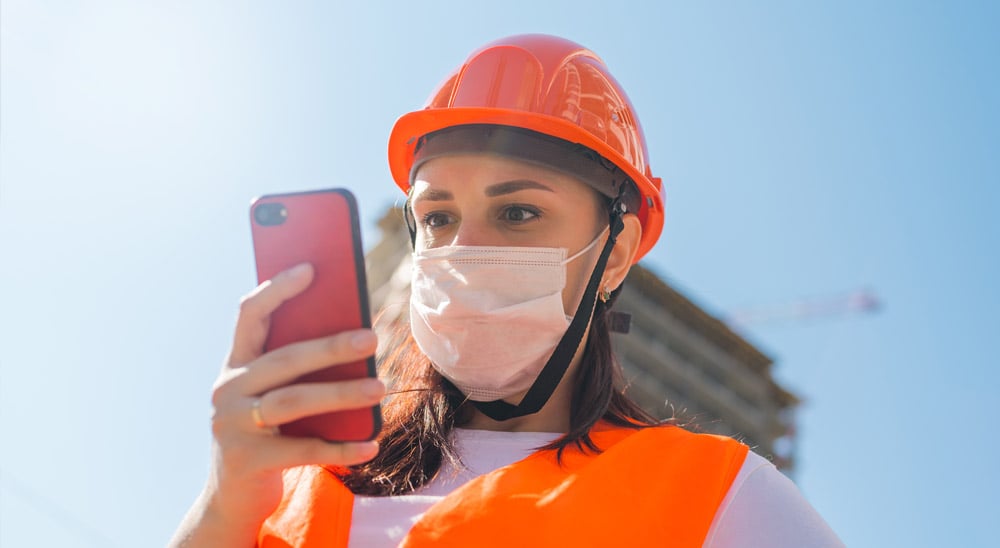
3-minute read
Social distancing tech is key for preventing the spread of COVID-19. There are differences in effectiveness between wearable technology and app-based systems, as well as the technology used to calculate social distance. Wearable technology, like the newly developed Halo wristband, carries certain key advantages.
As many companies return to work, social distancing continues to be a key factor in preventing outbreaks of COVID-19. This has led to a class of devices centered around social distancing. However, not all social distancing tech is created equal.
What all of these technologies have in common is that they notify their users if they come too close to another user. Their secondary function is to make contact tracing faster and more accurate: if an individual does test positive for COVID-19, management can easily track who they recently came in contact with, to prevent further spread of the disease.
App-Based vs. Wearable Tech
Technology that performs these functions can be divided into two categories: app-based and wearable. With app-based social distancing, an app installed on employees' phones uses location services to track each user’s location via GPS, or the app uses Bluetooth or Wi-Fi to detect close contacts. Wearable solutions are purpose-built devices that perform essentially the same functions but without the complications or obstacles of app-based systems.
One of the major downsides to app-based systems is they generally require employees to use their own data and location services, potentially compromising their data privacy. Additionally, in order to conserve smartphone battery life, many app-based solutions check location as infrequently as once every five minutes. This means the apps can miss crucial data, both for enforcing social distancing and for contact tracing.
By contrast, wearable tech isn’t tied to employees’ personal devices, meaning it’s much easier to protect private data. And because these devices have only one function, all of their battery power is dedicated to constant location checks, for up-to-the-moment social distancing warnings and tracking.
The biggest advantage that wearable technology has over app-based is that everyone uses the same system. Since employees must use their own devices for app-based systems, these systems are dependent on everyone having adequate battery life, consistent connectivity, and glitch-free operating systems. If there are issues with an individual’s smartphone, it may flag false contacts or, worse, miss some contacts. By contrast, wearable devices are a unified system in which every device is calibrated in the same way.
GPS
Most smartphones come equipped with GPS, which is great for navigating by vehicle and playing location-based games but not as useful when it comes to tracking social distancing. GPS is only accurate to around 16 feet. While the technology is improving, and certain techniques can make it more precise, it is not accurate enough to differentiate between devices that are 9 feet apart and under 6 feet apart.
Bluetooth
GPS measures the location of two devices separately and calculates the distance between them. Bluetooth has the advantage over GPS in that it directly measures the relative distance between the two devices. With some wearable Bluetooth systems, like Halo, devices are only ever linked with each other, reducing the chance of false measurements from smartphones or other devices.
One of the biggest advantages Bluetooth has over other technology for social distancing is that it’s a low-energy system, meaning it can stay on all day and provide ongoing notifications of relative distance. If you’ve ever used the GPS on your phone for a road trip or other long period of time, you know just how much battery life it can consume.
Halo Wearable Technology
One Bluetooth-activated social distancing wearable is Halo. Developed and produced in North America, Halo is a simple wristband that actively alerts workers to maintain safe physical distance. The wristband vibrates to notify the wearer when another band is within 6 feet. Halo also allows for contact tracing while maintaining worker privacy. Its system downloads interaction data between wristbands but does not track personally identifiable information or locations.
Let TPD Help You
If you are interested in learning more about Halo wristbands, or if you would like to purchase this dynamic technology for your business, please contact the qualified experts at TPD here, by email at info@tpd.com, or by phone at 1.888.685.3530. More information regarding this state-of-the-art technology can be found here.
Filed under COVID-19

.png?width=2400&name=HQ%20TPD%20careers%20hero%20(1).png)



